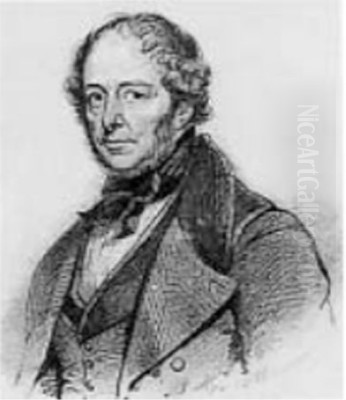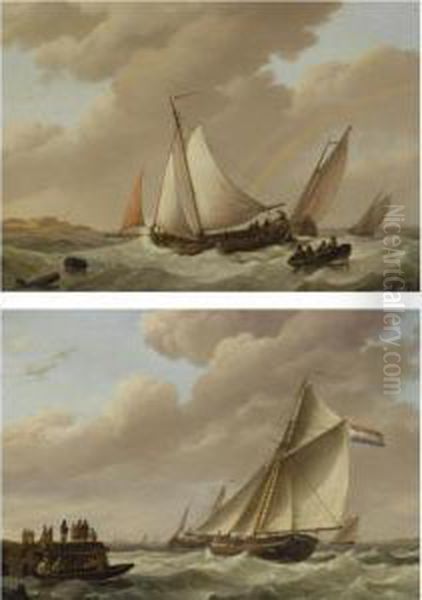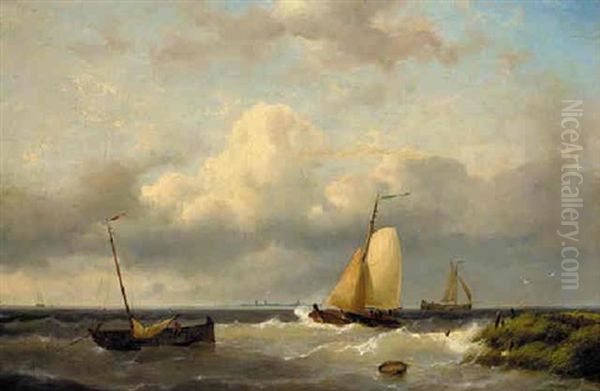
Johannes Hermanus Koekkoek (1778-1851) stands as a pivotal figure in the landscape of nineteenth-century Dutch art. Renowned primarily as a painter and printmaker of marine subjects, his work bridged the traditions of the Dutch Golden Age with the burgeoning Romantic sensibilities of his own era. Beyond his personal artistic achievements, Koekkoek holds the distinct honour of being the patriarch of the Koekkoek family, arguably the most significant dynasty of painters in the Netherlands during the 1800s. This article delves into the life, artistic style, key works, and enduring legacy of this influential Dutch master and the artistic family he founded.
Early Life and Artistic Formation
Born in the maritime town of Veere in the Dutch province of Zeeland in 1778, Johannes Hermanus Koekkoek's early life was intertwined with the sea and the artistic traditions of the region. His path to becoming a celebrated painter was not straightforward. Initially, he undertook an apprenticeship in a wallpaper factory, a trade that, while decorative, provided practical experience with design and materials. This period suggests an early inclination towards the visual arts, even within a more industrial context.
Despite his work commitments, Koekkoek's passion for painting drove him to seek formal instruction. He dedicated his evenings to studying at the Middelburg Drawing Academy (Middelburgse Teekenacademie). There, he honed his skills under the guidance of Thomas Gaal (1739-1817), an established local artist. This combination of practical work experience and academic training provided a solid foundation for his future career. His dedication paid off, and around 1806, his growing talent enabled him to establish his own independent painting studio.
Artistic Style and Influences
Johannes Hermanus Koekkoek specialized almost exclusively in marine painting, capturing the diverse moods of the seas and waterways of the Netherlands. His style is often characterized as a blend of detailed Realism and the atmospheric qualities associated with Romanticism. He possessed a remarkable ability to render ships with accuracy, paying close attention to rigging, sails, and the effects of wind and water on the vessels. His seascapes range from tranquil harbour scenes bathed in soft light to dramatic depictions of ships battling storms.

Koekkoek’s work demonstrates a profound respect for the Dutch marine painting tradition of the 17th century. The influence of Golden Age masters is palpable in his compositions, his treatment of light and atmosphere, and his meticulous attention to detail. Artists such as the renowned marine specialists Willem van de Velde the Elder and Willem van de Velde the Younger, known for their precise ship portraits and dramatic sea battles, and Ludolf Bakhuizen, famed for his powerful depictions of rough seas, clearly informed Koekkoek's approach. Furthermore, the influence of landscape painters like Meindert Hobbema, Aelbert Cuyp, and Jacob van Ruisdael can be seen in his handling of skies and coastal elements.
Beyond technical skill and historical influence, Koekkoek's paintings often convey a sense of national pride. His depictions of Dutch waters, bustling harbours, and the nation's maritime activities resonated with contemporary audiences, reflecting a love for his homeland and its seafaring heritage. This patriotic sentiment, combined with his technical prowess, contributed significantly to his popularity both within the Netherlands and internationally. His works were admired for their faithful yet evocative portrayal of the sea and nature.
Major Themes and Representative Works
The core of Johannes Hermanus Koekkoek's oeuvre revolves around the maritime life of the Netherlands. He frequently depicted coastal views, estuaries, and calm inland waters, often populated with various types of sailing vessels, from humble fishing boats to larger merchant ships. Figures are usually present, engaged in activities like fishing, loading cargo, or simply observing the scene, adding a human dimension to the vastness of the sea and sky.
One notable work, sometimes titled Shipwreck off the Zeeland Coast or Shipwreck near the Rotterdam Coast, showcases his ability to handle dramatic subjects. The painting depicts the aftermath of a storm, with a wrecked vessel near the shore and figures engaged in rescue efforts. It powerfully conveys the perils of the sea while also highlighting themes of human resilience and solidarity, potentially reflecting the Dutch spirit in facing adversity.
In contrast, works like Entering Harbour near the Shore exemplify his skill in rendering calmer, more picturesque scenes. Such paintings often feature a view from the land looking out to sea, perhaps with a lighthouse or jetty anchoring the composition. Boats navigate the waters, and importantly, the presence of the Dutch flag, as seen in some works, explicitly underscores the national context and Koekkoek's patriotic inclinations. The careful rendering of light, reflections on the water, and atmospheric perspective are hallmarks of these tranquil pieces.

Other titles attributed to him, such as Ships in a Harbour, Sailing Scene, Threatening Sky Over Sea Block, and Ship Extracted from Storm, further illustrate the range of his subject matter, from serene harbour views under sunny skies, reflecting Dutch maritime prowess and peace, to more turbulent scenes capturing the dynamic power of nature. Across all these themes, his commitment to realistic detail, particularly in the depiction of ships and water, remained constant.
The Koekkoek Dynasty: The Patriarch
Johannes Hermanus Koekkoek's most enduring legacy, perhaps even surpassing his own considerable artistic output, was the founding of an extraordinary artistic dynasty. He was the progenitor of a family that would dominate Dutch painting, particularly landscape and marine art, for much of the 19th century. He not only achieved success himself but also instilled a passion for art in his offspring, providing them with their initial training.
His role as a teacher extended primarily to his own family. Four of his sons followed him into the profession, each achieving recognition in their own right, ensuring the Koekkoek name became synonymous with high-quality Dutch painting during the Romantic period. This familial transmission of artistic knowledge and skill is a remarkable aspect of his life story.
The First Generation of Artists: The Sons
The artistic talents nurtured by Johannes Hermanus blossomed spectacularly in his sons. Each carved out a distinct niche within the art world, though often staying within the broader categories of landscape and marine painting favoured by their father.
The most celebrated of his sons was Barend Cornelis Koekkoek (1803-1862). Widely regarded as the preeminent landscape painter of Dutch Romanticism, he earned the moniker "Prince of Landscape Painting." While his father focused on the sea, Barend Cornelis excelled in depicting majestic forests, panoramic landscapes, and evocative winter scenes. His style combined meticulous Dutch detail with a Romantic sensibility, often bathed in warm, sometimes Italianate, light. His fame attracted prestigious patrons, including King William II of the Netherlands, King Frederick William IV of Prussia, and Tsar Alexander II of Russia. A testament to his standing, he founded his own successful drawing academy in Kleve, Germany, influencing another generation of artists. His teachers included his father and potentially Jean Augustin Daiwaille.
Marinus Adrianus Koekkoek (1807-1868), another son, also pursued a career as a painter. He is known for both landscape and marine subjects, working in a Romantic style that echoed the family's artistic inclinations. While perhaps not reaching the towering fame of Barend Cornelis, he was a respected artist contributing to the Dutch art scene.

Hermanus Koekkoek Sr. (1815-1882) followed most closely in his father's footsteps, specializing in marine and river scenes. He became one of the most accomplished marine painters of his generation, admired for his detailed and atmospheric depictions of Dutch waterways and coastal views. He successfully carried forward the family's strong tradition in marine art, adapting it to the evolving tastes of the mid-19th century.
(The provided text mentions four sons becoming artists, but consistently details these three. The identity or specific field of a fourth artistic son remains less clear from the source material provided.)
The Legacy Continues: The Grandsons
The Koekkoek artistic lineage did not end with Johannes Hermanus's sons. Several of his grandsons also became successful painters, extending the family's influence into the later 19th and early 20th centuries. They often continued the landscape and marine traditions established by their grandfather and fathers, while sometimes developing their own specializations.
Hermanus Koekkoek Jr. (1836-1909), son of Hermanus Sr., maintained the family's focus on marine subjects. He is particularly noted for his depictions of fishing boats and coastal life, capturing the daily activities along the Dutch shores with sensitivity and skill.
Willem Koekkoek (1839-1925), another son of Hermanus Sr., developed a distinct niche within the family's output. He became renowned for his highly detailed and charming Dutch townscapes, often depicting sunlit streets and canals flanked by traditional architecture. His work found considerable success, and he spent a significant part of his career working in London.
Hendrik Koekkoek (1840-1912), also a son of Hermanus Sr., demonstrated versatility. He painted forest scenes, landscapes, and marine subjects, working within the prevailing Romantic style. His work contributed to the breadth of the Koekkoek family's artistic production. (Note: Some sources might list a Hermanus Barend Koekkoek with similar dates, potentially referring to the same individual or another grandson).
The continuation of the artistic tradition across three generations underscores the profound impact Johannes Hermanus Koekkoek had, not just through his own paintings, but through the creative environment he fostered within his family.
Context and Connections
Johannes Hermanus Koekkoek worked during a period of transition in Dutch art, following the Golden Age and preceding the Hague School. His career unfolded within the context of European Romanticism. His primary teacher was Thomas Gaal, linking him to the established academic practices of the late 18th century.
The provided texts also mention connections with contemporaries such as Jan Pieter Willem van den Broeke and Jean Augustin Daiwaille (who also taught B.C. Koekkoek), suggesting his participation in the artistic networks of his time. To fully appreciate his position, it's helpful to consider other leading Dutch artists of the era. Andreas Schelfhout (1787-1870) was a dominant figure in Dutch Romantic landscape painting, particularly known for his winter scenes, and a contemporary whose success paralleled that of the Koekkoek family. Wijnand Nuijen (1813-1839), though short-lived, was another important Romantic painter known for his innovative landscapes and seascapes. Placing Koekkoek alongside these figures highlights his specific contribution – the revitalization and continuation of the Dutch marine painting tradition within a Romantic framework.
Enduring Recognition
The art of Johannes Hermanus Koekkoek continues to be held in high regard. His paintings are prized for their technical accomplishment, atmospheric beauty, and their evocative portrayal of Dutch maritime life. His works are represented in the collections of major Dutch museums, including the prestigious Rijksmuseum in Amsterdam and the Mauritshuis in The Hague, as well as in numerous private collections worldwide.
His significance extends beyond his individual canvases. As the founder of the Koekkoek dynasty, he played an instrumental role in shaping Dutch art in the 19th century. The collective output of the Koekkoek family represents a major contribution to the nation's artistic heritage, particularly within the genres of landscape and marine painting during the Romantic era.
Conclusion
Johannes Hermanus Koekkoek was more than just a skilled painter of ships and sea; he was a vital link between the glories of the Dutch Golden Age and the artistic developments of the 19th century. His dedication to marine painting, infused with Romantic sensibility and national pride, earned him lasting recognition. Furthermore, his role as the patriarch of an exceptionally talented family of artists cements his legacy. Through his own work and that of his descendants, Johannes Hermanus Koekkoek ensured that the beauty and dynamism of the Dutch landscape and seascape remained a vibrant subject in the nation's art for generations. His paintings continue to captivate viewers with their meticulous detail, atmospheric depth, and timeless depiction of the maritime world.